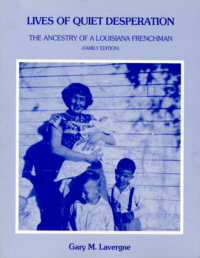|
|
||
|
While sitting on the front steps of a very modest home in the small Cajun community of Church Point in Louisiana, Nolan Lavergne talked to his son about the happiness and hardships of growing up on a tenant farm in rural St. Landry Parish. His son was a rookie high school American History teacher who asked a seemingly simple question: "Who was your grandfather?" The father did not know. "Well, Daddy, I'm going to find out for you," said the son. Thus began a fourteen-year-long project culminating in Lives of Quiet Desperation, a look at the ancestry of Gary M. Lavergne, a Louisianian of French descent. In addition to a substantial genealogy with over 1,200 names, Lavergne includes a series of concise essays placing generations in historical context. Special treatment is given to the forces that helped to determine the migrations of various groups of French-speaking people, and the pioneers who helped to build new worlds in Canada and French Louisiana. Particular emphasis is placed upon defining and describing the differences between Cajuns, Creoles, and other Louisiana French cultures. The vast majority of the ancestors were simple, poor, tenant farmers with large cohesive families. the uncommon were pioneers of note. they all faced considerable odds and led lives of quiet desperation. |
THE RICHARDS OF ILE ST. JEAN: Acadians Move to Louisiana From Lives of Quiet Desperation by Gary M. Lavergne Sometime around the year 1650, Michel Richard, a native of France, arrived in Acadia. He most likely arrived in Port Royal, a maritime center on the shores of the Bay of Fundy. Acadia, now known as Nova Scotia, was a maritime province of New France. The Acadians were peaceful people, normally engaged in fishing and agricultural pursuits. He is purported to have been born in the 1630s, but that is more likely an estimate which presumes him to be in his twenties at the time of his marriage to Madeline Blanchard in 1656, in Port Royal. Madeline was the daughter of Jean Blanchard and Rodigorde(?) Lambert. She was most likely a second generation Acadian. The Michel Richards were much like other Acadian families--large. They were to raise 10 children; Michel would later marry Jeanne Babin (Antoine and Marie Mercier) in 1682, and father two more children. For almost the next century the Richard family would grow exponentially. Michel's son, Martin, would marry Marguerite Bourg (Francois and Marguerite Boudrot) of Beaubassin and father 9 children. The Martin Richards would live in Beaubassin, a settlement that no longer exists but was located on the present-day border of Nova Scotia and New Brunswick on the northern shore of the Bay of Fundy. Martin Richard's second son, Alexander would later marry Madeline Thibodeaux in 1721, and they would raise 10 children. Sometime in the 1740s, however, the Alexander Richards would move from Beaubassin to Malpeque, on the island of St. Jean (Prince Edward Island). Alexander Richard and Madeline Thibodeaux's second son Pierre would marry Marguerite Dugas in 1752, just a few years before the Grand Derangement. The Grand Derangement, or the expulsion of the Acadians from Nova Scotia by the British, must have been an insufferable experience for Pierre Richard and Marguerite Dugas. Their first son Fabien, was born shortly after 1752, and was most likely the last Richard of this lineage born in Acadia. There is no record of the births of their next six children, suggesting that these events occurred during their refugee status or in remote areas not readily served by the Catholic clerics of the time. Whatever the case, the Pierre Richards appear in the Pointe Coupee area of Louisiana and later in and around Opelousas and Church Point. Fabien Richard was to marry Francoise Thibodeaux (Pierre and Francoise Sonnier) on 10 January 1779. The event was recorded in the St. Martinville Catholic Church; it is evident that by this time the Richards were securely settled in Louisiana. For the Richards the Acadian tradition of large families continued. Fabien Richard and Francoise Thibodeaux would have 12 children. The tradition of insularity would continue as well; each of those children to marry would marry other Louisiana French. The Richard experience is clearly a good example of the Cajun tradition itself, and the Cajun tradition is a good example of the theme of quiet desperation. Michel Richard arrived in the New World in the 1650s to find an area considered strategic and invaluable to both British and the French imperial ambitions. Struggles and wars ensued. One hundred years later, Pierre Richard would see the British win the struggle. He would be banished from his home, only to be relocated, ultimately, in Louisiana. The Richard family now flourishes in Louisiana, as well as other parts of the North America. The family was so large at the time of the Grand Derangement that it was inevitable for Richards to have been scattered. North Dakota, for example has a number of Richards, one of whom is Frank J. Richard, an engineer and historian by avocation. He is the author of a history of the Richard Family. There are Richards in Canada, near Montreal, and still others in France, whose ancestors were deported from Acadia during the Grand Derangement. It is quite likely that they are, like those before them, very hardy yet simple people. Wherever they are, or whatever they are doing, they are assuredly Cajun. ESSAYS
PICTURES
| Gary's Bio | Before Brown | Worse Than Death | Bad Boy From Rosebud | Sniper in the Tower | Cajuns | |
|

